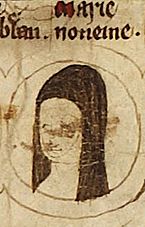Mary of Woodstock facts for kids
Quick facts for kids Mary of Woodstock |
|
|---|---|

Mary depicted on the family tree of the kings of England
|
|
| Born | 11 March 1278 Windsor Castle |
| Died | before 8 July 1332 Amesbury Priory |
| House | Plantagenet |
| Father | Edward I of England |
| Mother | Eleanor of Castile |
Mary of Woodstock (born March 11, 1278 – died before July 8, 1332) was a princess, the seventh daughter of Edward I of England and Eleanor of Castile. She became a nun at Amesbury Priory, a type of religious house for women. Even though she was a nun, she lived a very comfortable life because her parents gave her a lot of money. She also traveled quite a bit around the country, even when a rule from the Pope said nuns should stay in their convents.
Contents
Early Life as a Princess and Nun
Becoming a Nun
Mary's grandmother, Eleanor of Provence, decided to live at Amesbury Priory in Wiltshire. This priory was connected to a larger religious order called Fontevrault. Eleanor wanted Mary and another granddaughter, Eleanor of Brittany, to become Benedictine nuns there.
Mary's mother, Eleanor of Castile, wasn't sure about this idea. However, Mary joined Amesbury Priory in 1285 when she was seven years old. Thirteen daughters of noble families also joined at the same time. Mary officially became a nun in December 1291, when she was twelve.
A Comfortable Life
Mary's parents gave her £100 every year for the rest of her life. This was a lot of money back then, like having about £48,000 today. She also received double the usual amount of clothes and special access to wine. She lived very comfortably in her own private rooms.
Her father, King Edward I, visited her and Eleanor at the priory many times. He visited twice in 1286, again in 1289, and in 1290 and 1291. When Eleanor of Provence died in 1291, it was thought Mary might move to Fontevrault. The head nun of Fontevrault often wrote to King Edward I, asking for his daughter to live there. But King Edward refused, probably to keep his daughter safe in England if there was a war with France. So, Mary stayed at Amesbury.
Her yearly allowance was then doubled to £200. In 1292, she was also given the right to forty oak trees each year from royal forests. She also received twenty barrels of wine each year from Southampton.
Mary's Role and Travels
Traveling the Country
Even though Mary lived at the priory, she started to travel a lot around England. She visited her brother Edward in 1293. She also regularly attended the royal court, spending five weeks there in 1297. This was just before her sister Elizabeth left for Holland.
By the end of the 1200s, Mary held an important position. She was a vicegerent (someone who acts on behalf of a superior) and a visitatrix (someone who inspects religious houses) for the abbess (the head nun). This meant she could approve nuns moving between different convents.
In 1302, her £200 yearly payment was changed. Instead, she was given the rights to several manors (large estates) and the town of Wilton. She could keep these as long as she stayed in England. However, she ran up some debts while visiting her father's court. In 1305, she was given £200 to pay them off. She was also given Grovebury Priory in Bedfordshire to manage, and she kept this until her death.
Papal Rules and Perseverance
Mary did not manage to become a high-ranking leader in the order, unlike Eleanor of Brittany, who became abbess at Fontevrault in 1304. A special rule from the Pope, called the Periculoso (a papal bull), was read at Amesbury in 1303. This rule said that nuns should stay inside their religious buildings. However, Mary's travels didn't seem to be affected by this rule.
She went on many pilgrimages (religious journeys), including one to Canterbury. She continued to visit the royal court, sometimes with a group of up to twenty-four horses and even other nuns. Soon after 1313, her role as a visitor was taken away. In 1317, her brother Edward, who was now King Edward II, asked Eleanor to give Mary her job back. But Eleanor refused. Mary kept trying and eventually got a special order from the Pope that required her to be put back in her role. Eleanor seemed to follow this order.
Later Life and Legacy
Continued Comfort
Despite her disagreements with Eleanor, Mary continued to live comfortably. In 1316, she was able to borrow more than £2 from the abbey's money. This would be like borrowing about £300 today. She even sent a clerk (a type of assistant) to London for her own personal tasks, and the priory paid for it.
Mary was treated like a princess, not just a nun. Because of her royal status, a famous scholar and writer named Nicholas Trevet dedicated his book, Cronicles, to her between 1328 and 1334. This book was meant to be an entertaining history of the world and later became an important source for other popular books of that time.
Also, because of Mary's high status, several noble families who wanted their daughters to become nuns placed them in Mary's care.
Mary died before July 8, 1332, and was buried at Amesbury Priory.
Ancestors
| Ancestors of Mary of Woodstock | ||||||||||||||||||||||||||||||||||||||||||||||||||||||||||||||||||||||||||||||||||||||||||||||||||||||||||||||||||||||||||||||||||||||||||||||||||||||||||||||||||||||||||||||||||||||||||||||||||||||||||||||||||||||||||||||||||||||||||||||||||||||||||||||||||||||||||||||||||||||||||||||||||||||||||||||||||||||||||||||||||||||||||||||||||||||||||||||||||||||||||||||||||||||||||||||||||||||||||||||||||||||||||||||||||||||||||||||||||||||||||||||||||||||||||||||||||||||||||||||||||||||||||||||||||||||||||||||||||||||||||||||||||||||||||||||||||||||||||||||||||||||||||||||||||||||||||||||||
|---|---|---|---|---|---|---|---|---|---|---|---|---|---|---|---|---|---|---|---|---|---|---|---|---|---|---|---|---|---|---|---|---|---|---|---|---|---|---|---|---|---|---|---|---|---|---|---|---|---|---|---|---|---|---|---|---|---|---|---|---|---|---|---|---|---|---|---|---|---|---|---|---|---|---|---|---|---|---|---|---|---|---|---|---|---|---|---|---|---|---|---|---|---|---|---|---|---|---|---|---|---|---|---|---|---|---|---|---|---|---|---|---|---|---|---|---|---|---|---|---|---|---|---|---|---|---|---|---|---|---|---|---|---|---|---|---|---|---|---|---|---|---|---|---|---|---|---|---|---|---|---|---|---|---|---|---|---|---|---|---|---|---|---|---|---|---|---|---|---|---|---|---|---|---|---|---|---|---|---|---|---|---|---|---|---|---|---|---|---|---|---|---|---|---|---|---|---|---|---|---|---|---|---|---|---|---|---|---|---|---|---|---|---|---|---|---|---|---|---|---|---|---|---|---|---|---|---|---|---|---|---|---|---|---|---|---|---|---|---|---|---|---|---|---|---|---|---|---|---|---|---|---|---|---|---|---|---|---|---|---|---|---|---|---|---|---|---|---|---|---|---|---|---|---|---|---|---|---|---|---|---|---|---|---|---|---|---|---|---|---|---|---|---|---|---|---|---|---|---|---|---|---|---|---|---|---|---|---|---|---|---|---|---|---|---|---|---|---|---|---|---|---|---|---|---|---|---|---|---|---|---|---|---|---|---|---|---|---|---|---|---|---|---|---|---|---|---|---|---|---|---|---|---|---|---|---|---|---|---|---|---|---|---|---|---|---|---|---|---|---|---|---|---|---|---|---|---|---|---|---|---|---|---|---|---|---|---|---|---|---|---|---|---|---|---|---|---|---|---|---|---|---|---|---|---|---|---|---|---|---|---|---|---|---|---|---|---|---|---|---|---|---|---|---|---|---|---|---|---|---|---|---|---|---|---|---|---|---|---|---|---|---|---|---|---|---|---|---|---|---|---|---|---|---|---|---|---|---|---|---|---|---|---|---|---|---|---|---|---|---|---|---|---|---|---|---|---|---|---|---|---|---|---|---|---|---|---|---|---|---|---|---|---|---|---|---|---|---|---|---|---|---|---|---|---|---|---|---|---|---|---|---|---|---|---|---|---|---|---|---|---|---|---|---|---|---|---|---|---|---|---|---|---|---|---|---|---|---|---|---|---|---|---|---|---|---|---|---|---|---|---|---|---|---|---|---|---|---|---|---|---|---|---|---|---|---|---|---|---|---|---|---|---|---|---|---|---|---|---|---|---|---|---|---|---|---|---|---|---|---|---|---|
|
||||||||||||||||||||||||||||||||||||||||||||||||||||||||||||||||||||||||||||||||||||||||||||||||||||||||||||||||||||||||||||||||||||||||||||||||||||||||||||||||||||||||||||||||||||||||||||||||||||||||||||||||||||||||||||||||||||||||||||||||||||||||||||||||||||||||||||||||||||||||||||||||||||||||||||||||||||||||||||||||||||||||||||||||||||||||||||||||||||||||||||||||||||||||||||||||||||||||||||||||||||||||||||||||||||||||||||||||||||||||||||||||||||||||||||||||||||||||||||||||||||||||||||||||||||||||||||||||||||||||||||||||||||||||||||||||||||||||||||||||||||||||||||||||||||||||||||||||

